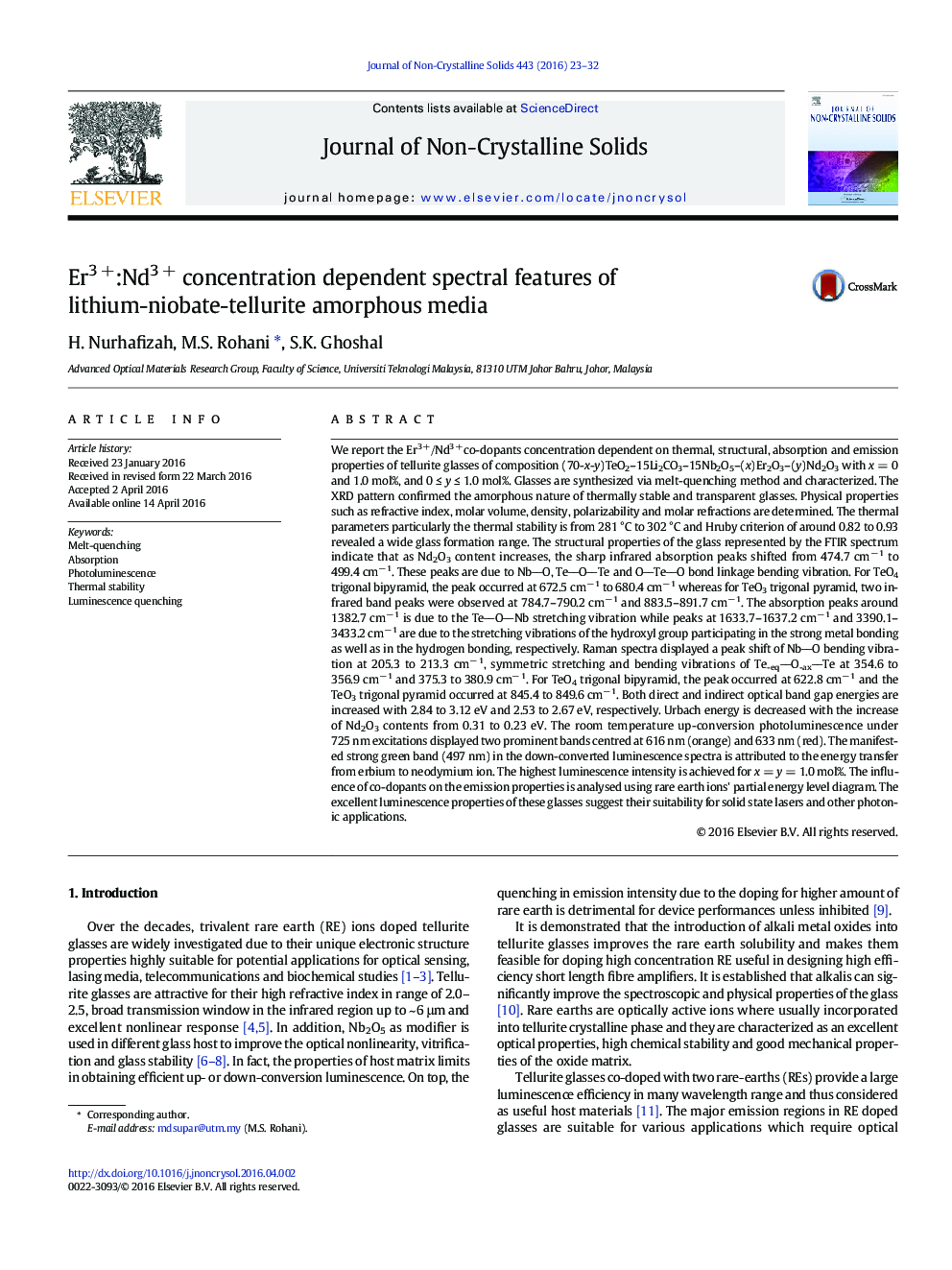| کد مقاله | کد نشریه | سال انتشار | مقاله انگلیسی | نسخه تمام متن |
|---|---|---|---|---|
| 1480211 | 1510402 | 2016 | 10 صفحه PDF | دانلود رایگان |

• Lithium niobate tellurite glasses with varying Er3 + and Nd3 + content have been synthesized.
• Spectral dependent properties of glass on rare-earth dopants depict the re-arrangement in structures and bonding of glass network.
• Energy transfer between pairs of Nd3 + ions and migration of excitation energy stimulated enhancement and quenching in luminescence.
We report the Er3 +/Nd3 + co-dopants concentration dependent on thermal, structural, absorption and emission properties of tellurite glasses of composition (70-x-y)TeO2–15Li2CO3–15Nb2O5–(x)Er2O3–(y)Nd2O3 with x = 0 and 1.0 mol%, and 0 ≤ y ≤ 1.0 mol%. Glasses are synthesized via melt-quenching method and characterized. The XRD pattern confirmed the amorphous nature of thermally stable and transparent glasses. Physical properties such as refractive index, molar volume, density, polarizability and molar refractions are determined. The thermal parameters particularly the thermal stability is from 281 °C to 302 °C and Hruby criterion of around 0.82 to 0.93 revealed a wide glass formation range. The structural properties of the glass represented by the FTIR spectrum indicate that as Nd2O3 content increases, the sharp infrared absorption peaks shifted from 474.7 cm− 1 to 499.4 cm− 1. These peaks are due to NbO, TeOTe and OTeO bond linkage bending vibration. For TeO4 trigonal bipyramid, the peak occurred at 672.5 cm− 1 to 680.4 cm− 1 whereas for TeO3 trigonal pyramid, two infrared band peaks were observed at 784.7–790.2 cm− 1 and 883.5–891.7 cm− 1. The absorption peaks around 1382.7 cm− 1 is due to the TeONb stretching vibration while peaks at 1633.7–1637.2 cm− 1 and 3390.1–3433.2 cm− 1 are due to the stretching vibrations of the hydroxyl group participating in the strong metal bonding as well as in the hydrogen bonding, respectively. Raman spectra displayed a peak shift of NbO bending vibration at 205.3 to 213.3 cm− 1, symmetric stretching and bending vibrations of Te-eqO-axTe at 354.6 to 356.9 cm− 1 and 375.3 to 380.9 cm− 1. For TeO4 trigonal bipyramid, the peak occurred at 622.8 cm− 1 and the TeO3 trigonal pyramid occurred at 845.4 to 849.6 cm− 1. Both direct and indirect optical band gap energies are increased with 2.84 to 3.12 eV and 2.53 to 2.67 eV, respectively. Urbach energy is decreased with the increase of Nd2O3 contents from 0.31 to 0.23 eV. The room temperature up-conversion photoluminescence under 725 nm excitations displayed two prominent bands centred at 616 nm (orange) and 633 nm (red). The manifested strong green band (497 nm) in the down-converted luminescence spectra is attributed to the energy transfer from erbium to neodymium ion. The highest luminescence intensity is achieved for x = y = 1.0 mol%. The influence of co-dopants on the emission properties is analysed using rare earth ions' partial energy level diagram. The excellent luminescence properties of these glasses suggest their suitability for solid state lasers and other photonic applications.
Journal: Journal of Non-Crystalline Solids - Volume 443, 1 July 2016, Pages 23–32